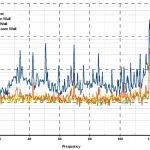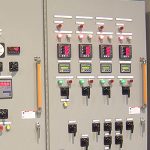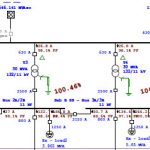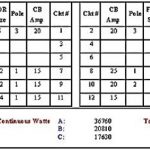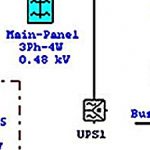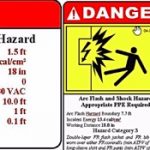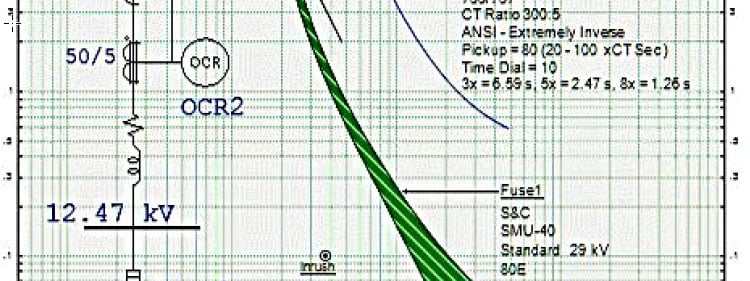
Carelabs is authorized provider of Electrical Installation’s Study, Analysis, Inspection, and Certification services in UAE, and offer short circuit study and analysis services.
Short Circuit
A short circuit is the flow of electricity in an unintended path of lower resistance or diversion of electricity. Short circuits result from unintended connections to ground, two points of different voltages coming into contact, or two phases contacting each other. In many cases the flow of electricity is through near-zero resistance connection, resulting in very high electricity levels.
When Short Circuit Dangerous?
A short circuit current can very large. This can result in large, rapid releases of energy in the form of heat, intense magnetic fields, and even potentially as explosions known as an arc blast. The heat can damage or destroy wiring insulation and electrical components. An arc blast produces a shock wave that may carry vaporized or molten metal, and can fatal to unprotected people who are close by.
Bolted, Arcing and Ground Faults
A connected failure usually results from a manufacturing or assembly error that results in two conductors of different voltages being “bolted” together, or source of power directly connected to ground. Since the connectors are solidly bolted there in no arc created and the high current quickly trips a protective device limiting the damage.
An arc fault is in which short circuit creates an arc. An arc is a flow of electricity between two conductors that are not in contact. The resulting intense heat can result in a fire, significant damage to the equipment, and possibly an arc flash or arc blast resulting in serious injuries.
A ground fault is in which electricity finds an unintended, low resistance path to ground. When that path goes through a human body the resulting heat can cause serious burns, and the electrical shock can disrupt the functioning of the human heart (fibrillation).
Symmetrical and Asymmetrical Currents
A polyphase system may experience either a symmetrical or an asymmetrical failure. Symmetrical failure electricity affects all phases equally. If some of the phases affected unequally, then the fault current is asymmetrical.
Symmetrical faults are comparatively simple to analyse, however they account for very few failures. Only about 5% of faults are symmetrical. Asymmetrical faults are more difficult to analyse, but they are the more common type of fault.
Protective Devices for Short Circuit Analysis
Protective devices designed to detect a fault condition and shut off the electricity before significant damage. There are a number of different types of protective devices, the two most common are:
Fuses and Circuit Breakers
Fuses and circuit breakers used to protect an electrical circuit from an over-current situation, usually resulting from short circuit, by cutting off the power supply. Fuses can only be used once. Circuit breakers may reset and used multiple times.
Ground Fault Interrupter (GFI)
This device detects when the electricity flow in the energized conductor are not equal to return electricity in the neutral conductor. The Ground Fault Interrupter protects people by quickly cutting off the electric flow preventing injuries resulting from shock. Ground Fault hecklers are typically used in homes for bathroom, kitchen, and outdoor electrical sockets. The Ground Fault Interrupter will typically be built into the electrical socket.
A Ground Fault Interrupter does not give over-current protection, and the circuit that includes a Ground Fault Interrupter will include a fuse or circuit breaker.
As well as fuses, circuit breakers, and GFIs, there are electrical protection devices that:
- Detect changes in current or voltage levels
- Guide the ratio of voltage to current
- Give over-voltage protection
- Give under-voltage protection
- Detect reverse-current flow
- Detect phase reversal
Benefits of Short Circuit Analysis
Conducting a short circuit analysis has the following benefits:
- Helps avoid unplanned outages and downtime.
- Is critical for avoiding interruptions of essential services
- Reduces the risk of equipment damage and fires
- Increases safety and protects people from injuries
- Determines the level and type of protective devices that needed.
- Provides the information needed for NEC and NFPA required labels
- Keeps you compliance NEC requirements
Short Circuit Current Calculation
NEC 110 requires that a short circuit analysis done for all electrical equipment and panels. The most accepted standards for short circuit analysis are the ANSI/IEEE C37.010-1979 standard and the International Electrotechnical Commission (IEC) 60909 standard.
The ANSI C37.010 standard intended to use for power circuit breaker choice, but it does give information needed for NEC 110 required labelling. The IEC 60909-3:2009 standard is more generic. It proposed to give general guidance for short-circuit analysis of any asymmetrical short circuit in three-phase 50 Hz or 60Hz A.C. electrical system.
Either the ANSI or the IEC short circuit calculation method can use. They compared and found to produce similar results. The ANSI method is generally used in short circuit analysis software. Sometimes it may feel that the IEC method lends itself to manual calculations.

